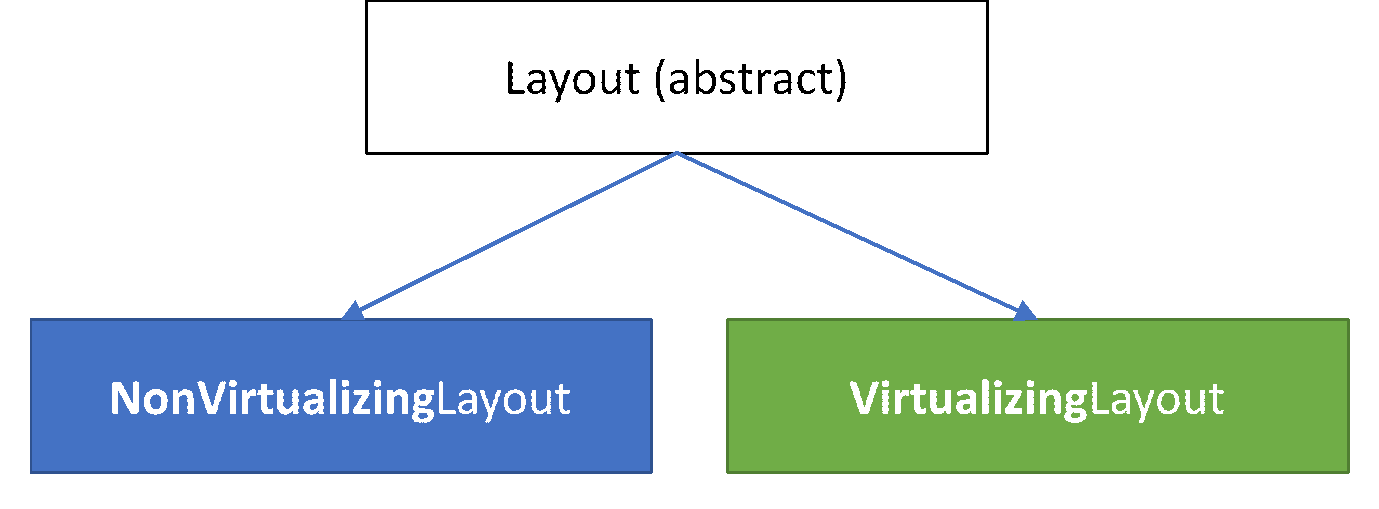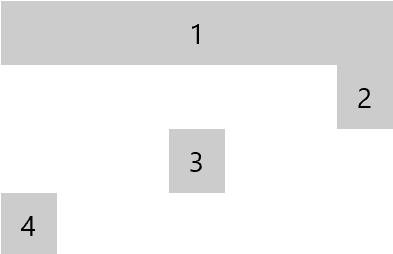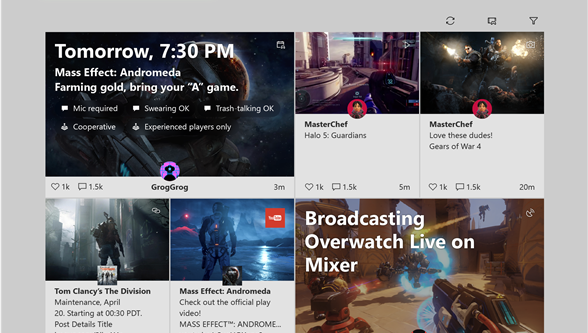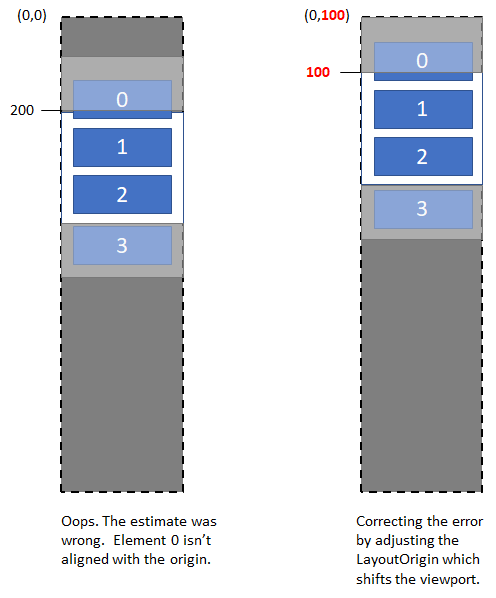附加的布局
将自身的布局逻辑委托给另一个对象的容器(例如“面板”)依赖附加的布局对象来为其子元素提供布局行为。 附加的布局模型使应用程序能够灵活地在运行时更改各项的布局,或者在不同的 UI 部分之间更轻松地共享布局的各个方面(例如,一张表的行内各项在列中显示对齐)。
在本主题中,我们将介绍创建附加布局(虚拟化和非虚拟化)时所涉及的内容、需要了解的概念和类,以及在确定是使用虚拟化还是非虚拟化布局时需要考虑的权衡。
| 获取 WinUI |
|---|
| 此控件作为 WinUI 的一部分提供,该库是一个 Nuget 包,其中包含用于 Windows 应用的新控件和 UI 功能。 有关详细信息(包括安装说明),请参阅 WinUI 概述。 |
重要的 API:
重要概念
执行布局需要针对每个元素解答两个问题:
此元素多大?
此元素将置于何处?
我们在自定义面板的讨论部分中简要介绍了 XAML 的布局系统(会对上述问题进行解答)。
容器和上下文
从概念上讲,XAML 的“面板”会填充框架中的两个重要角色:
- 它可以包含子元素,并在元素树中引入分支。
- 它会对这些子元素应用特定的布局策略。
因此,XAML 中的“面板”通常与布局的意思相同,但从技术方面讲,该“面板”不仅仅只是布局。
ItemsRepeater 的行为也与“面板”相似,但与“面板”不同的是,它不会公开将以编程方式添加或删除 UIElement 子元素的子属性。 相反,其子元素的生存期是自动由框架管理的,以便与数据项集合相对应。 尽管它不是派生自“面板”,但它的行为与“面板”相似,并且像“面板”那样由框架进行处理。
注意
LayoutPanel 是一个派生自“面板”的容器,它将其逻辑委托给附加的布局对象。 LayoutPanel 处于“预览版”状态,目前仅可用于 WinUI 包的“预发行版”中。
容器
从概念上讲,面板是元素的容器,还可以为背景呈现像素。 “面板”提供了在易于使用的包中封装通用布局逻辑的方法。
附加的布局的概念让容器和布局这两个角色之间的区别更加清楚明确。 如果容器将其布局逻辑委托给另一个对象,我们会称该对象为附加的布局,如以下代码片段所示。 从 FrameworkElement 继承的容器(例如 LayoutPanel)会自动公开为 XAML 的布局过程提供输入的通用属性(例如“Height”和“Width”)。
<LayoutPanel>
<LayoutPanel.Layout>
<UniformGridLayout/>
</LayoutPanel.Layout>
<Button Content="1"/>
<Button Content="2"/>
<Button Content="3"/>
</LayoutPanel>
在布局过程中,容器依赖附加的 UniformGridLayout 来度量其子元素并对其进行排列。
每个容器的状态
使用附加布局时,布局对象的单个实例可能与以下代码片段中类似的许多容器相关联;因此,它不能依靠宿主容器,也不能直接引用主机容器。 例如:
<!-- ... --->
<Page.Resources>
<ExampleLayout x:Name="exampleLayout"/>
<Page.Resources>
<LayoutPanel x:Name="example1" Layout="{StaticResource exampleLayout}"/>
<LayoutPanel x:Name="example2" Layout="{StaticResource exampleLayout}"/>
<!-- ... --->
在这种情况下,ExampleLayout 必须仔细考虑它在其布局计算中使用的状态,还要考虑该状态的存储位置,避免对一个面板中的其他元素布局造成影响。 它类似于自定义“面板”,该面板的 MeasureOverride 和 ArrangeOverride 逻辑取决于其静态属性的值。
LayoutContext
LayoutContext 的目的是应对这些挑战。 它使附加的布局能够与主机容器进行交互,例如检索子元素,而不引入二者之间的直接依赖项。 此外,上下文可以使布局存储任何可能与容器的子元素相关的所需状态。
简单的非虚拟化布局通常不需要保持任何状态,因此不存在问题。 但是,更复杂的布局(例如“网格”)可能会从度量值和排列调用中选择一个状态来保持,从而避免重新计算值。
虚拟化布局经常需要在度量和排列之间以及迭代布局过程之间保持某种状态。
初始化和取消初始化每个容器的状态
将布局附加到容器时,会调用其 InitializeForContextCore 方法,并提供初始化对象的机会来存储状态。
同样,布局从容器中被删除时,将调用 UninitializeForContextCore 方法。 这样,布局就有机会清除它与该容器关联的任何状态。
布局的状态对象可与上下文中的 LayoutState 属性一起存储在容器中并可从中检索。
UI 虚拟化
UI 虚拟化意味着延迟创建 UI 对象,直到需要时才创建。 这是一种性能优化措施。 对于非滚动方案而言,确定何时需要进行创建可能会根据应用特定的事物数量而定。 在这些情况下,应用应考虑使用 x:Load。 不需要在布局中进行任何特殊处理。
在基于滚动的方案中(例如列表),确定何时需要进行创建这一事项通常会根据“是否将对用户可见”而定,这一点很大程度上取决于布局过程中它被放置的位置,并且需要特别考虑。 此方案是本文档的重点。
注意
虽然本文档中未介绍,但在滚动方案中实现 UI 虚拟化的功能也可以应用于非滚动方案。 例如,有一种数据驱动的 ToolBar 控件,可管理它所呈现命令的生存期,并通过在可见区域和溢出菜单之间回收/移动元素来响应可用空间中的更改。
入门
首先,确定需要创建的布局是否应支持 UI 虚拟化。
请注意以下几点………
- 非虚拟化布局更易于创作。 如果项数始终都较少,则建议创作非虚拟化布局。
- 此平台提供一组附加的布局,这些布局适用于 ItemsRepeater 和 LayoutPanel 以满足常见需求。 先熟悉这些需求,再确定是否需要定义自定义布局。
- 与非虚拟化布局相比,虚拟化布局始终具有额外的 CPU 和内存成本/复杂性/开销。 根据一般的经验法则,如果布局需要管理的子元素可能适合一个面积为视区 3 倍大小的区域,虚拟化布局带来的益处则不太多。 此文档稍后将更详细地讨论这一 3 倍大小,但这是出于在 Windows 上滚动的异步性质及其对虚拟化的影响所进行的。
提示
作为参考,ListView(和 ItemsRepeater)的默认设置为直到项数足以填充当前视区的 3 倍大小才开始回收。
选择基类型

基本布局类型具有两个派生类型,这两个类型作为创作附加的布局的起点:
非虚拟化布局
创建非虚拟化布局的方法对于任何创建过自定义面板的人而言应该非常熟悉了。 它们在概念上是相同的。 主要区别在于 NonVirtualizingLayoutContext 用于访问子元素集合,并且布局可能会选择存储状态。
- 从基类型 NonVirtualizingLayout 派生(而不是从面板派生)。
- (可选)定义更改后会使布局失效的依赖项属性。
- (新的/可选)将布局所需的任何状态对象初始化为 InitializeForContextCore 的一部分。 使用随上下文提供的 LayoutState 将它与主机容器一起存储。
- 替代 MeasureOverride,并对所有子元素调用度量方法。
- 替代 ArrangeOverride,并对所有子元素调用排列方法。
- (新的/可选)清理所有作为 UninitializeForContextCore 一部分保存的状态。
示例:简单的堆叠布局(项的大小可变)

下面是一个非常基本的非虚拟化堆叠布局,项的大小可变。 它缺少用于调整布局行为的任何属性。 以下实现说明了布局是如何依靠容器提供的上下文对象来执行以下操作:
- 获取子元素的数量,以及
- 按索引访问每个子元素。
public class MyStackLayout : NonVirtualizingLayout
{
protected override Size MeasureOverride(NonVirtualizingLayoutContext context, Size availableSize)
{
double extentHeight = 0.0;
foreach (var element in context.Children)
{
element.Measure(availableSize);
extentHeight += element.DesiredSize.Height;
}
return new Size(availableSize.Width, extentHeight);
}
protected override Size ArrangeOverride(NonVirtualizingLayoutContext context, Size finalSize)
{
double offset = 0.0;
foreach (var element in context.Children)
{
element.Arrange(
new Rect(0, offset, finalSize.Width, element.DesiredSize.Height));
offset += element.DesiredSize.Height;
}
return finalSize;
}
}
<LayoutPanel MaxWidth="196">
<LayoutPanel.Layout>
<local:MyStackLayout/>
</LayoutPanel.Layout>
<Button HorizontalAlignment="Stretch">1</Button>
<Button HorizontalAlignment="Right">2</Button>
<Button HorizontalAlignment="Center">3</Button>
<Button>4</Button>
</LayoutPanel>
虚拟化布局
与非虚拟化布局类似,针对虚拟化布局的高级步骤是相同的。 复杂性很大程度上在于确定哪些元素会出现在视区内以及应该实现哪些元素。
- 派生自基类型 VirtualizingLayout。
- (可选)定义更改后会使布局失效的依赖项属性。
- 将布局所需的任何状态对象初始化为 InitializeForContextCore 的一部分。 使用随上下文提供的 LayoutState 将它与主机容器一起存储。
- 替代 MeasureOverride,并为应该实现的每个子元素调用度量方法。
- GetOrCreateElementAt 方法用于检索由框架准备的 UIElement(例如应用的数据绑定)。
- 替代 ArrangeOverride,并对每一个已实现的子元素调用排列方法。
- (可选)清理所有作为 UninitializeForContextCore 一部分保存的状态。
提示
MeasureOverride 返回的值用作虚拟化内容的大小。
在创作虚拟化布局时,可考虑两种常规的方法。 选择哪种方法在很大程度上取决于“如何确定元素的大小”。 如果它足以知道数据集中某项的索引,或者数据本身就决定了其最终大小,我们则认为它与数据相关。 这些创建方法更直接。 但是,如果只能通过创建并度量 UI 来确定项的大小,那么我们会说它与内容相关。 这些方法更复杂。
布局过程
无论是要创建数据相关或是内容相关的布局,理解布局过程和 Windows 异步滚动的影响都很重要。
从启动到在屏幕上显示 UI,框架所执行的(过于)简化步骤是:
它会解析标记。
生成元素树。
执行布局处理过程。
执行呈现处理过程。
通过 UI 虚拟化,在确定创建了足够用于填充视区的内容后,创建通常在步骤 2 中执行的元素这一操作会延迟或提前结束。 虚拟化容器(例如 ItemsRepeater)会根据其附加的布局来推动此进程。 它使用 VirtualizingLayoutContext(可显示虚拟化布局所需的额外信息)提供附加的布局。
RealizationRect(即视区)
在 Windows 上进行滚动与 UI 线程是异步的。 它不受框架的布局所控制。 相反,交互和移动发生在系统的合成器中。 此方法的优点在于总能以 60fps 的速率完成内容的平移。 然而,难点在于,布局所示的“视区”相对于屏幕上实际显示的内容会稍稍过时。 如果用户快速进行滚动,他们滚动的速度可能会超过 UI 线程生成新内容和“平移到黑色”的速度。 因此,虚拟化布局通常需要生成一个额外的已准备元素缓冲区,使这些元素足以填充大于视区的区域。 如果在滚动过程中负载较重,仍然会向用户显示内容。

由于元素创建成本较高,虚拟化容器(例如 ItemsRepeater)最初会使用与视区匹配的 RealizationRect 来提供附加的布局。 空闲时,容器可以通过使用越来越大的实现矩形重复调用布局,从而增加已准备内容的缓冲区。 此行为是一种性能优化措施,试图在快速启动时间与良好的平移体验之间取得平衡。 ItemsRepeater 将生成的最大缓冲区大小由其 VerticalCacheLength 和 HorizontalCacheLength 属性控制。
重新使用元素(回收)
布局应在每次运行时确定要填充 RealizationRect 的元素的大小和位置。 默认情况下,VirtualizingLayout 将在每个布局处理过程结束时回收所有未使用的元素。
作为 MeasureOverride 和 ArrangeOverride 的一部分被传递到布局的 VirtualizingLayoutContext 提供虚拟化布局所需的其他信息。 它提供的一些最常用的功能是:
- 查询数据中的项数 (ItemCount)。
- 使用 GetItemAt 方法检索特定项。
- 检索 RealizationRect,它表示布局应使用已实现元素进行填充的视区和缓冲区。
- 使用 GetOrCreateElement 方法请求特定项的 UIElement。
为给定索引请求元素将导致该元素针对该布局的传递被标记为“正在使用”。 如果该元素尚不存在,它则将被实现并且自动准备就绪(例如扩展 DataTemplate 中定义的 UI 树,处理任何数据绑定等)。 否则,将从现有实例的池中检索它。
每个度量处理结束时,会自动将任何未标记为“正在使用”的现有已实现元素都视为可重复使用,除非在通过 GetOrCreateElementAt 方法检索到元素时使用了 SuppressAutoRecycle 选项。 框架会自动将它移动到回收池并使其可用。 它随后可供其他容器使用。 框架会尽量避免这种情况发生,因为重新提供父级元素存在一定的成本。
如果虚拟化布局在每次度量开始时就知道哪些元素将不再位于实现矩形内,它则可以优化其重复使用功能。 而不是依赖框架的默认行为。 布局可以通过使用 RecycleElement 方法预先将元素移动到回收池。 在请求新元素之前调用此方法会让这些现有元素在布局稍后对尚未与元素关联的索引发出 GetOrCreateElementAt 请求时可用。
VirtualizingLayoutContext 提供了两个附加属性,供布局创作者用于创建内容相关的布局。 我们稍后将对它们进行更详细的讨论。
- RecommendedAnchorIndex,为布局提供可选的输入。
- LayoutOrigin,布局的一项可选输出。
数据相关的虚拟化布局
如果你在无需对要显示的内容进行度量的情况下知道每项的大小,使用虚拟化布局会更加简单。 在本文档中,我们将这类虚拟化布局简单地称为“数据布局”,原因在于它们通常都涉及检查数据。 根据具体的数据,应用可能会选取大小已知的可视化表示,这可能是因为它的数据部分或是因为之前是由设计决定的。
常规方法是对布局进行以下操作:
- 计算每项的大小和位置。
- 作为 MeasureOverride 的一部分:
- 使用 RealizationRect 确定哪些项应出现在视区中。
- 使用 GetOrCreateElementAt 方法检索应表示项的 UIElement。
- 使用预先计算的大小度量 UIElement。
- 作为 ArrangeOverride 的一部分,使用预先计算的位置排列每个已实现的 UIElement。
注意
数据布局方法通常与数据虚拟化不兼容。 具体而言,加载到内存中的唯一数据是填充用户可见内容所需的数据。 数据虚拟化并不是指用户向下滚动到数据驻留位置时延迟或增量加载数据。 相反,它指的是各项何时从内存中被释放,因为它们会被滚动到视图之外。 拥有一个将每一数据项作为数据布局一部分进行检查的数据布局会阻止数据虚拟化按预期方式工作。 有一个例外是 UniformGridLayout 之类的布局,它假定所有内容都具有相同的大小。
提示
如果要为控件库创建自定义控件,将供其他人在各种情况下使用,则不选择数据布局。
示例:Xbox 活动信息提要布局
Xbox 活动信息提要的 UI 使用了重复模式,即每行都有一个宽磁贴,后跟两个窄磁贴,后面行上宽磁贴和窄磁贴的顺序则是倒转过来的。 在此布局中,每项的大小是项在数据集中的位置以及磁贴的已知大小(宽和窄)的函数。

下面的代码演示了活动信息提要的自定义虚拟化 UI 可能是什么,用于说明你可能会为数据布局采用的常规方法。
提示
如果已安装 WinUI 3 库应用,请单击此处打开此应用,了解 ItemsRepeater 的实际应用。 通过 Microsoft Store 获取应用,或在 GitHub 上获取源代码。
实现
/// <summary>
/// This is a custom layout that displays elements in two different sizes
/// wide (w) and narrow (n). There are two types of rows
/// odd rows - narrow narrow wide
/// even rows - wide narrow narrow
/// This pattern repeats.
/// </summary>
public class ActivityFeedLayout : VirtualizingLayout // STEP #1 Inherit from base attached layout
{
// STEP #2 - Parameterize the layout
#region Layout parameters
// We'll cache copies of the dependency properties to avoid calling GetValue during layout since that
// can be quite expensive due to the number of times we'd end up calling these.
private double _rowSpacing;
private double _colSpacing;
private Size _minItemSize = Size.Empty;
/// <summary>
/// Gets or sets the size of the whitespace gutter to include between rows
/// </summary>
public double RowSpacing
{
get { return _rowSpacing; }
set { SetValue(RowSpacingProperty, value); }
}
/// <summary>
/// Gets or sets the size of the whitespace gutter to include between items on the same row
/// </summary>
public double ColumnSpacing
{
get { return _colSpacing; }
set { SetValue(ColumnSpacingProperty, value); }
}
public Size MinItemSize
{
get { return _minItemSize; }
set { SetValue(MinItemSizeProperty, value); }
}
public static readonly DependencyProperty RowSpacingProperty =
DependencyProperty.Register(
nameof(RowSpacing),
typeof(double),
typeof(ActivityFeedLayout),
new PropertyMetadata(0, OnPropertyChanged));
public static readonly DependencyProperty ColumnSpacingProperty =
DependencyProperty.Register(
nameof(ColumnSpacing),
typeof(double),
typeof(ActivityFeedLayout),
new PropertyMetadata(0, OnPropertyChanged));
public static readonly DependencyProperty MinItemSizeProperty =
DependencyProperty.Register(
nameof(MinItemSize),
typeof(Size),
typeof(ActivityFeedLayout),
new PropertyMetadata(Size.Empty, OnPropertyChanged));
private static void OnPropertyChanged(DependencyObject obj, DependencyPropertyChangedEventArgs args)
{
var layout = obj as ActivityFeedLayout;
if (args.Property == RowSpacingProperty)
{
layout._rowSpacing = (double)args.NewValue;
}
else if (args.Property == ColumnSpacingProperty)
{
layout._colSpacing = (double)args.NewValue;
}
else if (args.Property == MinItemSizeProperty)
{
layout._minItemSize = (Size)args.NewValue;
}
else
{
throw new InvalidOperationException("Don't know what you are talking about!");
}
layout.InvalidateMeasure();
}
#endregion
#region Setup / teardown // STEP #3: Initialize state
protected override void InitializeForContextCore(VirtualizingLayoutContext context)
{
base.InitializeForContextCore(context);
var state = context.LayoutState as ActivityFeedLayoutState;
if (state == null)
{
// Store any state we might need since (in theory) the layout could be in use by multiple
// elements simultaneously
// In reality for the Xbox Activity Feed there's probably only a single instance.
context.LayoutState = new ActivityFeedLayoutState();
}
}
protected override void UninitializeForContextCore(VirtualizingLayoutContext context)
{
base.UninitializeForContextCore(context);
// clear any state
context.LayoutState = null;
}
#endregion
#region Layout // STEP #4,5 - Measure and Arrange
protected override Size MeasureOverride(VirtualizingLayoutContext context, Size availableSize)
{
if (this.MinItemSize == Size.Empty)
{
var firstElement = context.GetOrCreateElementAt(0);
firstElement.Measure(new Size(double.PositiveInfinity, double.PositiveInfinity));
// setting the member value directly to skip invalidating layout
this._minItemSize = firstElement.DesiredSize;
}
// Determine which rows need to be realized. We know every row will have the same height and
// only contain 3 items. Use that to determine the index for the first and last item that
// will be within that realization rect.
var firstRowIndex = Math.Max(
(int)(context.RealizationRect.Y / (this.MinItemSize.Height + this.RowSpacing)) - 1,
0);
var lastRowIndex = Math.Min(
(int)(context.RealizationRect.Bottom / (this.MinItemSize.Height + this.RowSpacing)) + 1,
(int)(context.ItemCount / 3));
// Determine which items will appear on those rows and what the rect will be for each item
var state = context.LayoutState as ActivityFeedLayoutState;
state.LayoutRects.Clear();
// Save the index of the first realized item. We'll use it as a starting point during arrange.
state.FirstRealizedIndex = firstRowIndex * 3;
// ideal item width that will expand/shrink to fill available space
double desiredItemWidth = Math.Max(this.MinItemSize.Width, (availableSize.Width - this.ColumnSpacing * 3) / 4);
// Foreach item between the first and last index,
// Call GetElementOrCreateElementAt which causes an element to either be realized or retrieved
// from a recycle pool
// Measure the element using an appropriate size
//
// Any element that was previously realized which we don't retrieve in this pass (via a call to
// GetElementOrCreateAt) will be automatically cleared and set aside for later re-use.
// Note: While this work fine, it does mean that more elements than are required may be
// created because it isn't until after our MeasureOverride completes that the unused elements
// will be recycled and available to use. We could avoid this by choosing to track the first/last
// index from the previous layout pass. The diff between the previous range and current range
// would represent the elements that we can pre-emptively make available for re-use by calling
// context.RecycleElement(element).
for (int rowIndex = firstRowIndex; rowIndex < lastRowIndex; rowIndex++)
{
int firstItemIndex = rowIndex * 3;
var boundsForCurrentRow = CalculateLayoutBoundsForRow(rowIndex, desiredItemWidth);
for (int columnIndex = 0; columnIndex < 3; columnIndex++)
{
var index = firstItemIndex + columnIndex;
var rect = boundsForCurrentRow[index % 3];
var container = context.GetOrCreateElementAt(index);
container.Measure(
new Size(boundsForCurrentRow[columnIndex].Width, boundsForCurrentRow[columnIndex].Height));
state.LayoutRects.Add(boundsForCurrentRow[columnIndex]);
}
}
// Calculate and return the size of all the content (realized or not) by figuring out
// what the bottom/right position of the last item would be.
var extentHeight = ((int)(context.ItemCount / 3) - 1) * (this.MinItemSize.Height + this.RowSpacing) + this.MinItemSize.Height;
// Report this as the desired size for the layout
return new Size(desiredItemWidth * 4 + this.ColumnSpacing * 2, extentHeight);
}
protected override Size ArrangeOverride(VirtualizingLayoutContext context, Size finalSize)
{
// walk through the cache of containers and arrange
var state = context.LayoutState as ActivityFeedLayoutState;
var virtualContext = context as VirtualizingLayoutContext;
int currentIndex = state.FirstRealizedIndex;
foreach (var arrangeRect in state.LayoutRects)
{
var container = virtualContext.GetOrCreateElementAt(currentIndex);
container.Arrange(arrangeRect);
currentIndex++;
}
return finalSize;
}
#endregion
#region Helper methods
private Rect[] CalculateLayoutBoundsForRow(int rowIndex, double desiredItemWidth)
{
var boundsForRow = new Rect[3];
var yoffset = rowIndex * (this.MinItemSize.Height + this.RowSpacing);
boundsForRow[0].Y = boundsForRow[1].Y = boundsForRow[2].Y = yoffset;
boundsForRow[0].Height = boundsForRow[1].Height = boundsForRow[2].Height = this.MinItemSize.Height;
if (rowIndex % 2 == 0)
{
// Left tile (narrow)
boundsForRow[0].X = 0;
boundsForRow[0].Width = desiredItemWidth;
// Middle tile (narrow)
boundsForRow[1].X = boundsForRow[0].Right + this.ColumnSpacing;
boundsForRow[1].Width = desiredItemWidth;
// Right tile (wide)
boundsForRow[2].X = boundsForRow[1].Right + this.ColumnSpacing;
boundsForRow[2].Width = desiredItemWidth * 2 + this.ColumnSpacing;
}
else
{
// Left tile (wide)
boundsForRow[0].X = 0;
boundsForRow[0].Width = (desiredItemWidth * 2 + this.ColumnSpacing);
// Middle tile (narrow)
boundsForRow[1].X = boundsForRow[0].Right + this.ColumnSpacing;
boundsForRow[1].Width = desiredItemWidth;
// Right tile (narrow)
boundsForRow[2].X = boundsForRow[1].Right + this.ColumnSpacing;
boundsForRow[2].Width = desiredItemWidth;
}
return boundsForRow;
}
#endregion
}
internal class ActivityFeedLayoutState
{
public int FirstRealizedIndex { get; set; }
/// <summary>
/// List of layout bounds for items starting with the
/// FirstRealizedIndex.
/// </summary>
public List<Rect> LayoutRects
{
get
{
if (_layoutRects == null)
{
_layoutRects = new List<Rect>();
}
return _layoutRects;
}
}
private List<Rect> _layoutRects;
}
(可选)管理项到 UIElement 的映射
默认情况下,VirtualizingLayoutContext 会在其所表示的数据源中的已实现元素与索引之间保持映射。 当通过 GetOrCreateElementAt 方法检索元素时,布局可以通过始终请求 SuppressAutoRecycle 选项来选择管理此映射本身,这样可阻止默认的自动回收行为。 布局可以选择执行此操作,例如,当仅在滚动限制在一个方向时使用它并且它考虑的项始终是连续的时候(即知道第一个和最后一个元素的索引就足以知道应该实现的所有元素)。
示例:Xbox 活动信息提要度量
下面的代码片段显示了可添加到前面示例中的 MeasureOverride 的附加逻辑,用于管理映射。
protected override Size MeasureOverride(VirtualizingLayoutContext context, Size availableSize)
{
//...
// Determine which items will appear on those rows and what the rect will be for each item
var state = context.LayoutState as ActivityFeedLayoutState;
state.LayoutRects.Clear();
// Recycle previously realized elements that we know we won't need so that they can be used to
// fill in gaps without requiring us to realize additional elements.
var newFirstRealizedIndex = firstRowIndex * 3;
var newLastRealizedIndex = lastRowIndex * 3 + 3;
for (int i = state.FirstRealizedIndex; i < newFirstRealizedIndex; i++)
{
context.RecycleElement(state.IndexToElementMap.Get(i));
state.IndexToElementMap.Clear(i);
}
for (int i = state.LastRealizedIndex; i < newLastRealizedIndex; i++)
{
context.RecycleElement(context.IndexElementMap.Get(i));
state.IndexToElementMap.Clear(i);
}
// ...
// Foreach item between the first and last index,
// Call GetElementOrCreateElementAt which causes an element to either be realized or retrieved
// from a recycle pool
// Measure the element using an appropriate size
//
for (int rowIndex = firstRowIndex; rowIndex < lastRowIndex; rowIndex++)
{
int firstItemIndex = rowIndex * 3;
var boundsForCurrentRow = CalculateLayoutBoundsForRow(rowIndex, desiredItemWidth);
for (int columnIndex = 0; columnIndex < 3; columnIndex++)
{
var index = firstItemIndex + columnIndex;
var rect = boundsForCurrentRow[index % 3];
UIElement container = null;
if (state.IndexToElementMap.Contains(index))
{
container = state.IndexToElementMap.Get(index);
}
else
{
container = context = context.GetOrCreateElementAt(index, ElementRealizationOptions.ForceCreate | ElementRealizationOptions.SuppressAutoRecycle);
state.IndexToElementMap.Add(index, container);
}
container.Measure(
new Size(boundsForCurrentRow[columnIndex].Width, boundsForCurrentRow[columnIndex].Height));
state.LayoutRects.Add(boundsForCurrentRow[columnIndex]);
}
}
// ...
}
internal class ActivityFeedLayoutState
{
// ...
Dictionary<int, UIElement> IndexToElementMap { get; set; }
// ...
}
内容相关的虚拟化布局
如果必须首先测量项的 UI 内容以找出其准确大小,这则是与内容相关的布局。 你还可以将它视为这样一种布局,即其中每项都必须自行调整大小,而不是指示项大小的布局。 此类别的虚拟化布局更多。
注意
内容相关的布局不会(不应该)中断数据虚拟化。
估计
内容相关的布局会根据估计来猜测未实现内容的大小和已实现内容的位置。 这些估计变化时,它将导致已实现内容定期在可滚动区域内移动位置。 如果这种情况未得到缓解,可能会导致令人沮丧且不协调的用户体验。 此处讨论了潜在问题和缓解措施。
注意
考虑每一项且知道所有项(无论实现与否)的确切大小及其位置的数据布局可以完全避免这些问题。
滚动定位
XAML 提供了一种机制来缓解突然发生的视区移动,即通过实现 IScrollAnchorPovider 接口使滚动控件支持滚动定位。 当用户操作内容时,滚动控件会持续从选择要跟踪的候选集合中选择一个元素。 如果定位点元素的位置在布局期间发生改变,滚动控件则会自动移动它的视区以保持此视区。
为布局提供的 RecommendedAnchorIndex 值可以反映滚动控件选择的当前选定定位点元素。 或者,如果开发人员显式请求使用 ItemsRepeater 上的 GetOrCreateElement 方法来实现索引的元素,此索引则会作为下一个布局处理中的 RecommendedAnchorIndex。 这能够使布局针对开发人员实现元素并且随后请求通过 StartBringIntoView 方法将元素引入视图的可能方案做好准备。
RecommendedAnchorIndex 是数据源中的项的索引,此项是与内容相关的布局在估计其项的位置时应首先定位的。 它应作为定位其他已实现项的起点。
对 ScrollBar 的影响
即使使用滚动定位,如果布局的估计值变化很大(可能是由于内容大小有显著的变化),那么 ScrollBar 的滚动块位置可能看上去是跳跃的。 如果用户在拖动滚动块时看不到跟踪他们鼠标指针位置的滚动块,这可能会让他们感到不和谐。
其估计的布局越精确,用户看到 ScrollBar 的滚动块出现跳跃的可能性就越小。
布局更正
应准备好与内容相关的布局,从而合理处理估计情况与实际情况。 例如,当用户滚动到内容顶部并且布局实现了第一个元素时,它可能会发现,相对于其开始位置的元素,该元素的预期位置将导致该元素出现在除原点 (x:0, y:0) 之外的任何位置。 出现这种情况时,布局可以使用 LayoutOrigin 属性将它计算的位置设置为新布局的原点。 最终效果与滚动定位类似,滚动控件的视区会自动调整以覆盖布局所报告的内容位置。

断开连接的视区
从布局的 MeasureOverride 方法返回的大小表示对内容大小的最佳推测,此大小可能会随每一连续布局的变化而发生变化。 当用户滚动时,将使用更新的 RealizationRect 持续重新计算布局。
如果用户非常快速地拖动滚动块,从布局的角度来看,此视图则可能会在先前位置与当前位置不重叠的位置出现大幅跳跃的情况。 这是由于滚动的异步性质所致。 正在使用布局的应用也可以请求将当前未实现的项的元素带到视图中并且估计该元素位于布局跟踪的当前范围之外。
当布局发现其猜测不正确和/或发现意外的视区变化时,它需要重新调整其起始位置。 作为 XAML 控件一部分提供的虚拟化布局是作为内容相关的布局开发的,因为它们对要显示的内容的性质限制较少。
示例:项的大小可变的简单虚拟化堆叠布局
下面的示例演示了项的大小可变的简单堆叠布局,此布局:
- 支持 UI 虚拟化,
- 使用估计来猜测未实现项的大小,
- 了解可能发生的不连续视区偏移,以及
- 应用布局更正来纠正这些偏移。
用法:标记
<ScrollViewer>
<ItemsRepeater x:Name="repeater" >
<ItemsRepeater.Layout>
<local:VirtualizingStackLayout />
</ItemsRepeater.Layout>
<ItemsRepeater.ItemTemplate>
<DataTemplate x:Key="item">
<UserControl IsTabStop="True" UseSystemFocusVisuals="True" Margin="5">
<StackPanel BorderThickness="1" Background="LightGray" Margin="5">
<Image x:Name="recipeImage" Source="{Binding ImageUri}" Width="100" Height="100"/>
<TextBlock x:Name="recipeDescription"
Text="{Binding Description}"
TextWrapping="Wrap"
Margin="10" />
</StackPanel>
</UserControl>
</DataTemplate>
</ItemsRepeater.ItemTemplate>
</ItemsRepeater>
</ScrollViewer>
Codebehind: Main.cs
string _lorem = @"Lorem ipsum dolor sit amet, consectetur adipiscing elit. Etiam laoreet erat vel massa rutrum, eget mollis massa vulputate. Vivamus semper augue leo, eget faucibus nulla mattis nec. Donec scelerisque lacus at dui ultricies, eget auctor ipsum placerat. Integer aliquet libero sed nisi eleifend, nec rutrum arcu lacinia. Sed a sem et ante gravida congue sit amet ut augue. Donec quis pellentesque urna, non finibus metus. Proin sed ornare tellus. Lorem ipsum dolor sit amet, consectetur adipiscing elit. Etiam laoreet erat vel massa rutrum, eget mollis massa vulputate. Vivamus semper augue leo, eget faucibus nulla mattis nec. Donec scelerisque lacus at dui ultricies, eget auctor ipsum placerat. Integer aliquet libero sed nisi eleifend, nec rutrum arcu lacinia. Sed a sem et ante gravida congue sit amet ut augue. Donec quis pellentesque urna, non finibus metus. Proin sed ornare tellus.";
var rnd = new Random();
var data = new ObservableCollection<Recipe>(Enumerable.Range(0, 300).Select(k =>
new Recipe
{
ImageUri = new Uri(string.Format("ms-appx:///Images/recipe{0}.png", k % 8 + 1)),
Description = k + " - " + _lorem.Substring(0, rnd.Next(50, 350))
}));
repeater.ItemsSource = data;
代码:VirtualizingStackLayout.cs
// This is a sample layout that stacks elements one after
// the other where each item can be of variable height. This is
// also a virtualizing layout - we measure and arrange only elements
// that are in the viewport. Not measuring/arranging all elements means
// that we do not have the complete picture and need to estimate sometimes.
// For example the size of the layout (extent) is an estimation based on the
// average heights we have seen so far. Also, if you drag the mouse thumb
// and yank it quickly, then we estimate what goes in the new viewport.
// The layout caches the bounds of everything that are in the current viewport.
// During measure, we might get a suggested anchor (or start index), we use that
// index to start and layout the rest of the items in the viewport relative to that
// index. Note that since we are estimating, we can end up with negative origin when
// the viewport is somewhere in the middle of the extent. This is achieved by setting the
// LayoutOrigin property on the context. Once this is set, future viewport will account
// for the origin.
public class VirtualizingStackLayout : VirtualizingLayout
{
// Estimation state
List<double> m_estimationBuffer = Enumerable.Repeat(0d, 100).ToList();
int m_numItemsUsedForEstimation = 0;
double m_totalHeightForEstimation = 0;
// State to keep track of realized bounds
int m_firstRealizedDataIndex = 0;
List<Rect> m_realizedElementBounds = new List<Rect>();
Rect m_lastExtent = new Rect();
protected override Size MeasureOverride(VirtualizingLayoutContext context, Size availableSize)
{
var viewport = context.RealizationRect;
DebugTrace("MeasureOverride: Viewport " + viewport);
// Remove bounds for elements that are now outside the viewport.
// Proactive recycling elements means we can reuse it during this measure pass again.
RemoveCachedBoundsOutsideViewport(viewport);
// Find the index of the element to start laying out from - the anchor
int startIndex = GetStartIndex(context, availableSize);
// Measure and layout elements starting from the start index, forward and backward.
Generate(context, availableSize, startIndex, forward:true);
Generate(context, availableSize, startIndex, forward:false);
// Estimate the extent size. Note that this can have a non 0 origin.
m_lastExtent = EstimateExtent(context, availableSize);
context.LayoutOrigin = new Point(m_lastExtent.X, m_lastExtent.Y);
return new Size(m_lastExtent.Width, m_lastExtent.Height);
}
protected override Size ArrangeOverride(VirtualizingLayoutContext context, Size finalSize)
{
DebugTrace("ArrangeOverride: Viewport" + context.RealizationRect);
for (int realizationIndex = 0; realizationIndex < m_realizedElementBounds.Count; realizationIndex++)
{
int currentDataIndex = m_firstRealizedDataIndex + realizationIndex;
DebugTrace("Arranging " + currentDataIndex);
// Arrange the child. If any alignment needs to be done, it
// can be done here.
var child = context.GetOrCreateElementAt(currentDataIndex);
var arrangeBounds = m_realizedElementBounds[realizationIndex];
arrangeBounds.X -= m_lastExtent.X;
arrangeBounds.Y -= m_lastExtent.Y;
child.Arrange(arrangeBounds);
}
return finalSize;
}
// The data collection has changed, since we are maintaining the bounds of elements
// in the viewport, we will update the list to account for the collection change.
protected override void OnItemsChangedCore(VirtualizingLayoutContext context, object source, NotifyCollectionChangedEventArgs args)
{
InvalidateMeasure();
if (m_realizedElementBounds.Count > 0)
{
switch (args.Action)
{
case NotifyCollectionChangedAction.Add:
OnItemsAdded(args.NewStartingIndex, args.NewItems.Count);
break;
case NotifyCollectionChangedAction.Replace:
OnItemsRemoved(args.OldStartingIndex, args.OldItems.Count);
OnItemsAdded(args.NewStartingIndex, args.NewItems.Count);
break;
case NotifyCollectionChangedAction.Remove:
OnItemsRemoved(args.OldStartingIndex, args.OldItems.Count);
break;
case NotifyCollectionChangedAction.Reset:
m_realizedElementBounds.Clear();
m_firstRealizedDataIndex = 0;
break;
default:
throw new NotImplementedException();
}
}
}
// Figure out which index to use as the anchor and start laying out around it.
private int GetStartIndex(VirtualizingLayoutContext context, Size availableSize)
{
int startDataIndex = -1;
var recommendedAnchorIndex = context.RecommendedAnchorIndex;
bool isSuggestedAnchorValid = recommendedAnchorIndex != -1;
if (isSuggestedAnchorValid)
{
if (IsRealized(recommendedAnchorIndex))
{
startDataIndex = recommendedAnchorIndex;
}
else
{
ClearRealizedRange();
startDataIndex = recommendedAnchorIndex;
}
}
else
{
// Find the first realized element that is visible in the viewport.
startDataIndex = GetFirstRealizedDataIndexInViewport(context.RealizationRect);
if (startDataIndex < 0)
{
startDataIndex = EstimateIndexForViewport(context.RealizationRect, context.ItemCount);
ClearRealizedRange();
}
}
// We have an anchorIndex, realize and measure it and
// figure out its bounds.
if (startDataIndex != -1 & context.ItemCount > 0)
{
if (m_realizedElementBounds.Count == 0)
{
m_firstRealizedDataIndex = startDataIndex;
}
var newAnchor = EnsureRealized(startDataIndex);
DebugTrace("Measuring start index " + startDataIndex);
var desiredSize = MeasureElement(context, startDataIndex, availableSize);
var bounds = new Rect(
0,
newAnchor ?
(m_totalHeightForEstimation / m_numItemsUsedForEstimation) * startDataIndex : GetCachedBoundsForDataIndex(startDataIndex).Y,
availableSize.Width,
desiredSize.Height);
SetCachedBoundsForDataIndex(startDataIndex, bounds);
}
return startDataIndex;
}
private void Generate(VirtualizingLayoutContext context, Size availableSize, int anchorDataIndex, bool forward)
{
// Generate forward or backward from anchorIndex until we hit the end of the viewport
int step = forward ? 1 : -1;
int previousDataIndex = anchorDataIndex;
int currentDataIndex = previousDataIndex + step;
var viewport = context.RealizationRect;
while (IsDataIndexValid(currentDataIndex, context.ItemCount) &&
ShouldContinueFillingUpSpace(previousDataIndex, forward, viewport))
{
EnsureRealized(currentDataIndex);
DebugTrace("Measuring " + currentDataIndex);
var desiredSize = MeasureElement(context, currentDataIndex, availableSize);
var previousBounds = GetCachedBoundsForDataIndex(previousDataIndex);
Rect currentBounds = new Rect(0,
forward ? previousBounds.Y + previousBounds.Height : previousBounds.Y - desiredSize.Height,
availableSize.Width,
desiredSize.Height);
SetCachedBoundsForDataIndex(currentDataIndex, currentBounds);
previousDataIndex = currentDataIndex;
currentDataIndex += step;
}
}
// Remove bounds that are outside the viewport, leaving one extra since our
// generate stops after generating one extra to know that we are outside the
// viewport.
private void RemoveCachedBoundsOutsideViewport(Rect viewport)
{
int firstRealizedIndexInViewport = 0;
while (firstRealizedIndexInViewport < m_realizedElementBounds.Count &&
!Intersects(m_realizedElementBounds[firstRealizedIndexInViewport], viewport))
{
firstRealizedIndexInViewport++;
}
int lastRealizedIndexInViewport = m_realizedElementBounds.Count - 1;
while (lastRealizedIndexInViewport >= 0 &&
!Intersects(m_realizedElementBounds[lastRealizedIndexInViewport], viewport))
{
lastRealizedIndexInViewport--;
}
if (firstRealizedIndexInViewport > 0)
{
m_firstRealizedDataIndex += firstRealizedIndexInViewport;
m_realizedElementBounds.RemoveRange(0, firstRealizedIndexInViewport);
}
if (lastRealizedIndexInViewport >= 0 && lastRealizedIndexInViewport < m_realizedElementBounds.Count - 2)
{
m_realizedElementBounds.RemoveRange(lastRealizedIndexInViewport + 2, m_realizedElementBounds.Count - lastRealizedIndexInViewport - 3);
}
}
private bool Intersects(Rect bounds, Rect viewport)
{
return !(bounds.Bottom < viewport.Top ||
bounds.Top > viewport.Bottom);
}
private bool ShouldContinueFillingUpSpace(int dataIndex, bool forward, Rect viewport)
{
var bounds = GetCachedBoundsForDataIndex(dataIndex);
return forward ?
bounds.Y < viewport.Bottom :
bounds.Y > viewport.Top;
}
private bool IsDataIndexValid(int currentDataIndex, int itemCount)
{
return currentDataIndex >= 0 && currentDataIndex < itemCount;
}
private int EstimateIndexForViewport(Rect viewport, int dataCount)
{
double averageHeight = m_totalHeightForEstimation / m_numItemsUsedForEstimation;
int estimatedIndex = (int)(viewport.Top / averageHeight);
// clamp to an index within the collection
estimatedIndex = Math.Max(0, Math.Min(estimatedIndex, dataCount));
return estimatedIndex;
}
private int GetFirstRealizedDataIndexInViewport(Rect viewport)
{
int index = -1;
if (m_realizedElementBounds.Count > 0)
{
for (int i = 0; i < m_realizedElementBounds.Count; i++)
{
if (m_realizedElementBounds[i].Y < viewport.Bottom &&
m_realizedElementBounds[i].Bottom > viewport.Top)
{
index = m_firstRealizedDataIndex + i;
break;
}
}
}
return index;
}
private Size MeasureElement(VirtualizingLayoutContext context, int index, Size availableSize)
{
var child = context.GetOrCreateElementAt(index);
child.Measure(availableSize);
int estimationBufferIndex = index % m_estimationBuffer.Count;
bool alreadyMeasured = m_estimationBuffer[estimationBufferIndex] != 0;
if (!alreadyMeasured)
{
m_numItemsUsedForEstimation++;
}
m_totalHeightForEstimation -= m_estimationBuffer[estimationBufferIndex];
m_totalHeightForEstimation += child.DesiredSize.Height;
m_estimationBuffer[estimationBufferIndex] = child.DesiredSize.Height;
return child.DesiredSize;
}
private bool EnsureRealized(int dataIndex)
{
if (!IsRealized(dataIndex))
{
int realizationIndex = RealizationIndex(dataIndex);
Debug.Assert(dataIndex == m_firstRealizedDataIndex - 1 ||
dataIndex == m_firstRealizedDataIndex + m_realizedElementBounds.Count ||
m_realizedElementBounds.Count == 0);
if (realizationIndex == -1)
{
m_realizedElementBounds.Insert(0, new Rect());
}
else
{
m_realizedElementBounds.Add(new Rect());
}
if (m_firstRealizedDataIndex > dataIndex)
{
m_firstRealizedDataIndex = dataIndex;
}
return true;
}
return false;
}
// Figure out the extent of the layout by getting the number of items remaining
// above and below the realized elements and getting an estimation based on
// average item heights seen so far.
private Rect EstimateExtent(VirtualizingLayoutContext context, Size availableSize)
{
double averageHeight = m_totalHeightForEstimation / m_numItemsUsedForEstimation;
Rect extent = new Rect(0, 0, availableSize.Width, context.ItemCount * averageHeight);
if (context.ItemCount > 0 && m_realizedElementBounds.Count > 0)
{
extent.Y = m_firstRealizedDataIndex == 0 ?
m_realizedElementBounds[0].Y :
m_realizedElementBounds[0].Y - (m_firstRealizedDataIndex - 1) * averageHeight;
int lastRealizedIndex = m_firstRealizedDataIndex + m_realizedElementBounds.Count;
if (lastRealizedIndex == context.ItemCount - 1)
{
var lastBounds = m_realizedElementBounds[m_realizedElementBounds.Count - 1];
extent.Y = lastBounds.Bottom;
}
else
{
var lastBounds = m_realizedElementBounds[m_realizedElementBounds.Count - 1];
int lastRealizedDataIndex = m_firstRealizedDataIndex + m_realizedElementBounds.Count;
int numItemsAfterLastRealizedIndex = context.ItemCount - lastRealizedDataIndex;
extent.Height = lastBounds.Bottom + numItemsAfterLastRealizedIndex * averageHeight - extent.Y;
}
}
DebugTrace("Extent " + extent + " with average height " + averageHeight);
return extent;
}
private bool IsRealized(int dataIndex)
{
int realizationIndex = dataIndex - m_firstRealizedDataIndex;
return realizationIndex >= 0 && realizationIndex < m_realizedElementBounds.Count;
}
// Index in the m_realizedElementBounds collection
private int RealizationIndex(int dataIndex)
{
return dataIndex - m_firstRealizedDataIndex;
}
private void OnItemsAdded(int index, int count)
{
// Using the old indexes here (before it was updated by the collection change)
// if the insert data index is between the first and last realized data index, we need
// to insert items.
int lastRealizedDataIndex = m_firstRealizedDataIndex + m_realizedElementBounds.Count - 1;
int newStartingIndex = index;
if (newStartingIndex > m_firstRealizedDataIndex &&
newStartingIndex <= lastRealizedDataIndex)
{
// Inserted within the realized range
int insertRangeStartIndex = newStartingIndex - m_firstRealizedDataIndex;
for (int i = 0; i < count; i++)
{
// Insert null (sentinel) here instead of an element, that way we do not
// end up creating a lot of elements only to be thrown out in the next layout.
int insertRangeIndex = insertRangeStartIndex + i;
int dataIndex = newStartingIndex + i;
// This is to keep the contiguousness of the mapping
m_realizedElementBounds.Insert(insertRangeIndex, new Rect());
}
}
else if (index <= m_firstRealizedDataIndex)
{
// Items were inserted before the realized range.
// We need to update m_firstRealizedDataIndex;
m_firstRealizedDataIndex += count;
}
}
private void OnItemsRemoved(int index, int count)
{
int lastRealizedDataIndex = m_firstRealizedDataIndex + m_realizedElementBounds.Count - 1;
int startIndex = Math.Max(m_firstRealizedDataIndex, index);
int endIndex = Math.Min(lastRealizedDataIndex, index + count - 1);
bool removeAffectsFirstRealizedDataIndex = (index <= m_firstRealizedDataIndex);
if (endIndex >= startIndex)
{
ClearRealizedRange(RealizationIndex(startIndex), endIndex - startIndex + 1);
}
if (removeAffectsFirstRealizedDataIndex &&
m_firstRealizedDataIndex != -1)
{
m_firstRealizedDataIndex -= count;
}
}
private void ClearRealizedRange(int startRealizedIndex, int count)
{
m_realizedElementBounds.RemoveRange(startRealizedIndex, count);
if (startRealizedIndex == 0)
{
m_firstRealizedDataIndex = m_realizedElementBounds.Count == 0 ? 0 : m_firstRealizedDataIndex + count;
}
}
private void ClearRealizedRange()
{
m_realizedElementBounds.Clear();
m_firstRealizedDataIndex = 0;
}
private Rect GetCachedBoundsForDataIndex(int dataIndex)
{
return m_realizedElementBounds[RealizationIndex(dataIndex)];
}
private void SetCachedBoundsForDataIndex(int dataIndex, Rect bounds)
{
m_realizedElementBounds[RealizationIndex(dataIndex)] = bounds;
}
private Rect GetCachedBoundsForRealizationIndex(int relativeIndex)
{
return m_realizedElementBounds[relativeIndex];
}
void DebugTrace(string message, params object[] args)
{
Debug.WriteLine(message, args);
}
}
